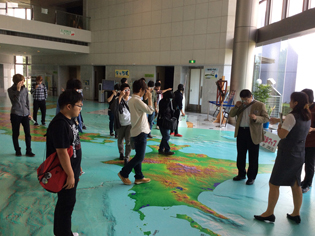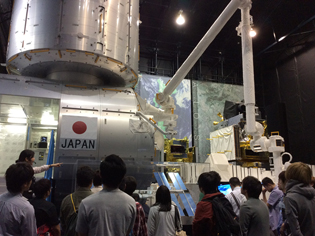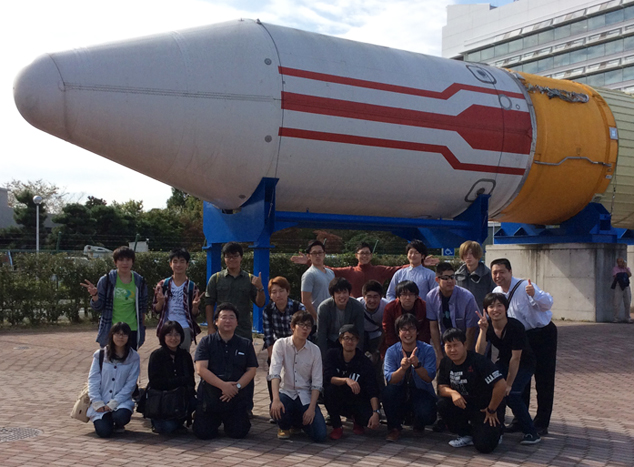On Thursday, September 30, 2015, 18 students from the Student Cooperative Class Projects (SCCPs) (*1) "Lunar and Planetary Data Analysis" and "JAXA TANPOPO project on the International Space Station" (*2), and ARC-Space toured four research institutions in Tsukuba City. The students were led by Senior Associate Professor Demura and Associate Professors Okudaira and Yaguchi.
Leaving the UoA in a chartered bus at 5:00 A.M, the group first arrived at the High Energy Accelerator Research Organization (KEK) (*3). After viewing a video introducing the institution, the students were led by KEK researchers on a tour of the Photon Factory, which was used to analyze the particles of the asteroid Itokawa brought back to earth by Hayabusa, as well as other facilities. The students were excited to visit a massive facility much larger than what they experience day-to-day at the university.
Next, the students visited the Science Museum of Map and Survey (*4) Listening to the tour guide, the students visited each of the exhibits. First, the students viewed the three-dimensional map of Japan drawn on the floor of the museum ("Walking on air over the Japanese archipelago") using 3D glasses. They were also able to learn about how surveying methods have evolved, the various ways in which geographical information is utilized, and about volcanoes, etc.
The students started their afternoon off with lunch at JAXA's Tsukuba Space Center (*5). Afterwards, the students were guided around the Space Dome exhibition pavilion, where they viewed mockups of various satellites, the International Space Station's "KIBO" Japanese Experiment Module, and the KOUNOTORI ISS cargo transporter. This tour, which required that the students pass through security checks, also allowed students to get a direct look at KIBO mission control room. This was particularly exciting for the students involved in the "Tanpopo Project" being run there.
The final tour of the day was of the Geological Museum (*6). With commentary provided by a researcher from Fukushima, the students were able to deepen their knowledge of Japan's mineral resources and geological composition. Worlds away from the type of geology in which observations are made indirectly with remote sensing data, the students were able to learn about real hands-on geology. In particular, being able to ask questions about volcanoes and earthquakes in front of a large geological model of the Japanese archipelago was a valuable learning experience.
Like previous years, each of the individual tours was conducted at breakneck speed. Despite this, the students were able to experience the subjects of the earth and space they deal with every day in class and in their research from a different perspective through the realistic mockups and commentary provided at each of the institutions.


"Walking on air over the Japanese archipelago," a three-dimensional map of Japan (Science Museum of Map and Survey, left), Students listen to an explanation in front of the "KIBO" module (Tsukuba Space Center, right)

Commemorative photo in front of a rocket (Tsukuba Space Center)
- *1 Student Cooperative Class Projects (SCCPs): SCCPs are courses open to students from their first year in undergraduate school that tackle a number of different themes set by instructors. These courses are one of the unique traits of the University of Aizu, and include a wide variety of subjects from typical UoA topics to language.
- *2 Tanpopo Project: A current Japanese space mission being conducted in the International Space Station's Japanese Experimental Module aiming to expose organic material/microorganisms to space and capture space dust/microorganisms.
News: "Tanpopo" Mission Successfully Launched! - *3 High Energy Accelerator Research Organization (KEK)
- *4 Science Museum of Map and Survey
- *5 JAXA Tsukuba Space Center
- *6 Geological Museum


